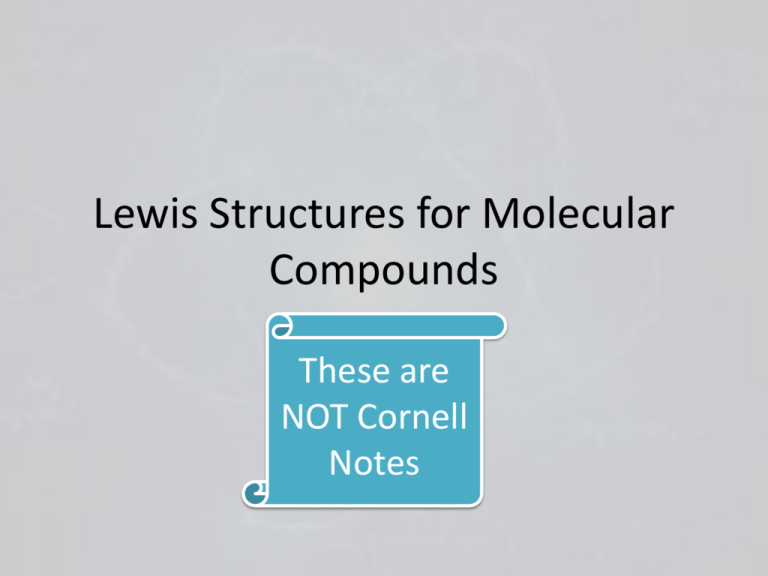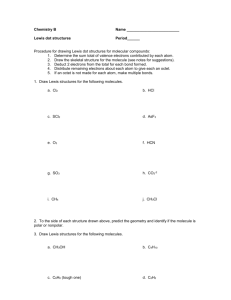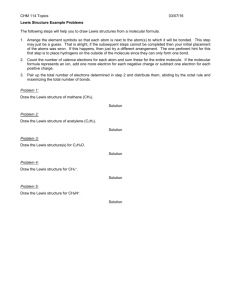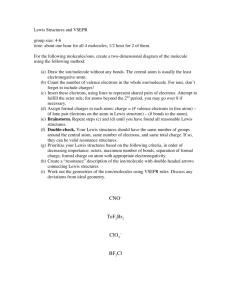Lewis Structures for Molecular Compounds
advertisement

Lewis Structures for Molecular Compounds These are NOT Cornell Notes Learning Objectives • Use a systematic procedure to draw Lewis structures that represent the formation of molecular compounds and polyatomic ions. Molecular Structures • Several models can be used to represent a molecule – – – – – Molecular formula Structural formula Space-filling model Ball-and-stick model Lewis structure PH3 Molecular Structure • One of the most useful molecular models is the structural formula, which uses letter symbols and bonds to show relative positions of atoms. • You can predict the structural formula for many molecules by drawing the Lewis structure. Lewis Structures • Bonding electrons – pairs of valence electrons that are shared between atoms – bonding electrons are represented by dashes • Nonbonding electrons – pairs of valence electrons that are not involved in a bond bonding electrons Systematic Procedure for Drawing Lewis Structures 1. Calculate the total number of valence electrons available. 2. Predict the location of atoms and write a skeletal structure. The atom that has the lowest electronegativity (see notes on page 128) will be the central atom. Lewis Structures • How do I know which atom is the central atom? – Common binary compound - look at molecular formula. Central atom – atom that appears once in formula. • Ex. SO2 – S is central atom – Molecular compounds that have hydrogen, oxygen, and an additional element - additional element is central atom • Ex: HNO3 – N is central atom Lewis Structures – Carbon is the central atom in nearly all carboncontaining compounds CH4 – C is central atom – Neither hydrogen nor fluorine is ever the central atom. Lewis Structures 3. Add nonbonding electron pairs to the structure such that each atom bonded to the central atom has an octet. 4. Place any remaining electrons on the central atom. Lewis Structures 5. If there are not enough electrons to give the central atom an octet, use one more pair of nonbonding electrons on the atoms bonded to the central atom to form double and triple bonds. 6. Count the total number of electrons in the completed Lewis structure to make sure it is equal to the total number of valence electrons available. Example 1 Copy this onto page 166 in your notebook Draw a Lewis structure for PF3. Example 2 Copy this onto page 167 in your notebook Draw a Lewis structure for HCN. Practice 1 Complete this on page 168 of your notebook. Show ALL steps. Draw a Lewis structure for SiCl4. Practice 2 Complete this on page 169 of your notebook. Show ALL steps. Draw a Lewis structure for H2CO. Lewis Structures for Polyatomic Ions • Use same procedure as for molecular compounds, with the accommodation that the total number of electrons used in the structure must be adjusted to take into account ion charge. Lewis Structures for Polyatomic Ions • In the Lewis structure for an ionic compound that contains a polyatomic ion, the positive and negative ions are treated separately to show that they are individual ions not linked by covalent bonds. Example 3 Copy this onto page 170 of your notebook. Draw a Lewis structure for SO42-. Practice #3 Complete this on page 171 of your notebook. Show all steps. Draw a Lewis structure for BrO3-. Summary Different models can be used to represent molecules. A systematic approach can be used when drawing Lewis structures for molecular compounds and polyatomic ions.



